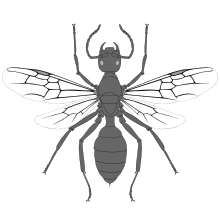Armaniidae
| Armaniidae Temporal range: Cenomanian - Turonian | |
|---|---|
 | |
| Artist's reconstruction of Orapia rayneri, an armaniid hymenopteran. | |
| Scientific classification | |
| Kingdom: | Animalia |
| Phylum: | Arthropoda |
| Class: | Insecta |
| Order: | Hymenoptera |
| Superfamily: | Vespoidea |
| Family: | †Armaniidae Dlussky, 1983 |
| Type genus | |
| †Armania | |
| Genera | |
| |
Armaniidae is an extinct family of ant-like hymenopterans known from a series of Cretaceous fossils found in Asia and Africa.[1] Armaniidae has been suggested by several authors to belong to the family Formicidae as one of the stem-group subfamilies, Armaniinae;[2] however, this position has not been taken up by most myrmecologists. The family currently contains seven described genera and thirteen described species.[3]
History and classification
Armaniidae is sometimes treated as the most basal of the Formicidae subfamilies, and classed as a stem-group which is more distant in relation to modern ants than the next stem group, Sphecomyrminae. More often the group, treated as "ant-like wasps",[3] is elevated to the rank of family, and considered as a possible sister group to Formicidae. It has been suggested by Engel and Grimaldi that the group may be paraphyletic.[3] This position is in contrast to the original hypothesis of Russian paleoentomologist Gennady Dlussky, who first described the family. Dlussky considered the group, when erected in 1983, have been an intermediate family bridging the families Scoliidae and the true formicids.[4] In contrast to both the treatment as a separate family and as a distinct subfamily, entomologist E. O. Wilson, in a 1987 paper, suggested that the then known armaniids and Sphecomyrma represented a single species. Wilson, in synonymizing the groups, made the hypothesis that the different described genera were actually fossils of different castes of the same species, with Sphecomyrma freyi being workers, Armania robusta being queens, and "Paleomyrmex" zherichini as the winged males.[5] This view was rejected as new fossils and species were described.[2]
The group is known exclusively from impression fossils which have a limited preservation quality, leading to the uncertainty of what features are present in the described species. Overall armaniids have a poorly developed petiole which is broadly attached to the thorax, short scapes on the antennae, and queen-like looking females.[4] The mandibles are vespid like, with possibly only one or two teeth, though this may be an artifact of preservation.[3] The short scape is a feature that is also seen in Sphecomyrminae members, and does not exclude armaniids from Formicidae.[2] Similarly the petiole is a feature that is seen in both the true formicids, and in the extinct chrysidoid wasp family Falsiformicidae, which is not related to formicids at all.[4] The two defining features of the true formicids are considered to be the presence of females which are divided into adult workers and queens. Currently no worker like armaniid specimens are known for the described species.[3] The presence of metapleural glands in some fossils has been reported by Dlussky,[6] but the veracity of the presence is uncertain.[3]
Genera and species
- Armaniinae Dlussky, 1983
- Archaeopone Dlussky, 1975
- Archaeopone kzylzharica Dlussky, 1975
- Archaeopone taylori Dlussky, 1983
- Armania Dlussky, 1983 (jr synonym = "Armaniella" Dlussky, 1983)
- Armania capitata Dlussky, 1983
- Armania curiosa (Dlussky, 1983)
- Armania pristina Dlussky, 1983
- Armania robusta Dlussky, 1983
- Dolichomyrma Dlussky, 1975
- Dolichomyrma latipes Dlussky, 1975
- Dolichomyrma longiceps Dlussky, 1975
- Khetania Dlussky, 1999
- Khetania mandibulata Dlussky, 1999
- Orapia Dlussky, Brothers & Rasnitsyn, 2004
- Orapia minor Dlussky, Brothers & Rasnitsyn, 2004
- Orapia rayneri Dlussky, Brothers & Rasnitsyn, 2004
- Poneropterus Dlussky, 1983
- Poneropterus sphecoides Dlussky, 1983
- Pseudarmania Dlussky, 1983
- Pseudarmania aberrans Dlussky, 1983
- Pseudarmania rasnitsyni Dlussky, 1983
- Archaeopone Dlussky, 1975
References
- ↑ Grimaldi, D.; Agosti, D.; Carpenter, J. M. (1997). "New and rediscovered primitive ants (Hymenoptera, Formicidae) in Cretaceous amber from New Jersey, and their phylogenetic relationships." (PDF). American Museum Novitates. 3208: 1–43.
- 1 2 3 Ward, P.S. (2007). "Phylogeny, classification, and species-level taxonomy of ants (Hymenoptera: Formicidae)" (PDF). Zootaxa. 1668: 549–563.
- 1 2 3 4 5 6 Engel, M.S.; Grimaldi, D.A. (2005). "Primitive New Ants in Cretaceous Amber from Myanmar, New Jersey, and Canada (Hymenoptera: Formicidae)". American Museum Novitates. 3485: 1–24. doi:10.1206/0003-0082(2005)485[0001:PNAICA]2.0.CO;2.
- 1 2 3 LaPolla, J.S.; Dlussky, G.M.; Perrichot, V. (2013). "Ants and the Fossil Record". Annual Review of Entomology. 58: 609–630. doi:10.1146/annurev-ento-120710-100600. PMID 23317048.
- ↑ Wilson, E.O. (1987). "The earliest known ants: an analysis of the Cretaceous species and an inference concerning their social organization". Paleobiology. 13 (1): 44–53. JSTOR 2400836.
- ↑ Dlussky, G.M. (1999). "The first find of the Formicoidea (Hymenoptera) in the lower Cretaceous of the northern hemisphere" (PDF). Paleontological Journal. 33 (3): 274–277.